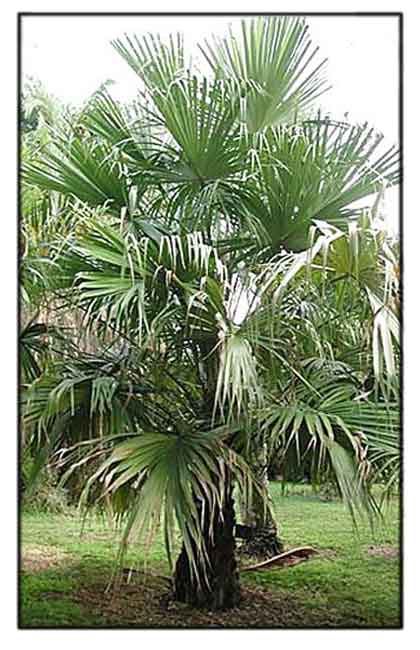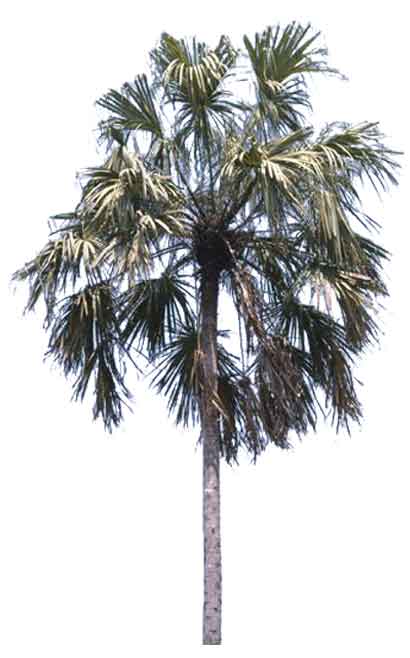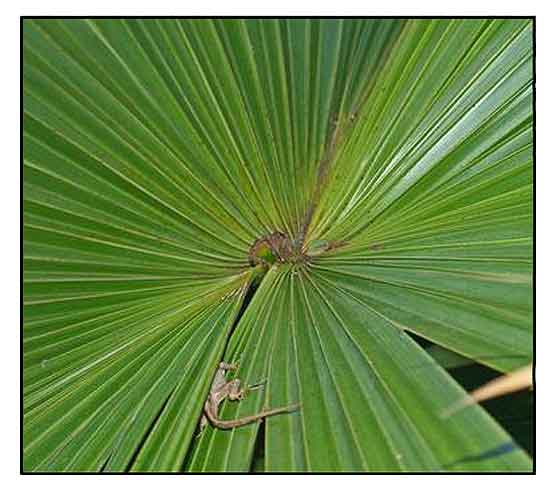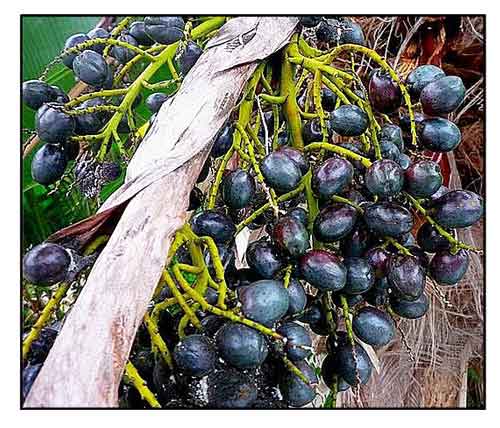 Gen info Gen info
- Livistona sari bus, tar aw palm, is a species of palm tree found in tropical Southeast Asia.
- Etymology: The genus name Livistona honors Patric Murray, baron of Livingston, ca. 1670, who devoted his collection and garden, which, later on, became the 'Royal Botanic Garden of Edinburgh'. (7) The species epithet sari bus may have derived from a local name of another palm species in one of the Maluku languages: saruboe, as recorded by the Dutch. (6)
Botany
Livistona sari bus is a large, solitary-stemmed, evergreen, fan palm. Stems to 40 m tall, to 65 cm in diam., rough with leaf scars. Leaves palmate; petioles 1-2 m, with green to brown, recurved spines along margins, spines denser proximally, fewer distally on petioles; blades almost circular in outline, 1.5-1.7 m wide, green adaxially and abaxially, irregularly divided for up to 1/2 their length into 80-90 segments, segments in groups, each group separated by a split almost to base of leaf, segments deeply split and pendulous at apices. Inflorescences to 2.3 m, branched to 3 orders, with 4-9 partial inflorescences; rachillae 15-45 cm; flowers borne in clusters of 3-5, yellowish, to 2 mm. Fruits blue or blue-gray, globose to ellipsoid, to 2.5 × 2 cm. (Flora of China) (3)
Hermaphroditic, Solitary palm. Trunk to 40 m tall, 15-65 cm in diameter; breast high, leaf scars raised, internodes broad, petiole stubs persistent in the basal 2 m or so. Leaves 25- 30 in a ± globose crown; petiole arching, 100-200 cm long, to 12 cm wide in proximal portion, to 15 mm wide in distal portion, adaxially flat to slightly ridged, glabrous, green to green-purple to green-red, glossy,  frequently with a reddish-purple longitudinal stripe; margins with large, single, retrorsely recurved, green to brown spines 10-60 mm long, largest and closer in the proximal portion; leaf-base fibres moderately fibrous, coarse, persistent; lamina costapalmate, irregularly segmented, with segments grouped and with divisions between each group of segments deeper into the lamina than the divisions between individual segments, subcircular, 80-200 cm long, 150-170 cm wide, adaxially green, abaxially a similar green; lamina divided into groups of 2-12 segments separated from adjacent groups by a deep split that almost reaches the hastula; lamina divided for 37-78% of its length, with 80-90 segments, depth of apical cleft 19-50% of the segment length, apical lobes pendulous; parallel veins 6-7 each side of midrib; transverse veins thinner than parallel veins. Inflorescences unbranched at the base, 60-230 cm long, not extending beyond the limit of the crown, curving, branched to 4 orders; partial inflorescences 4-9, 45-60 cm long; prophyll not seen; peduncular bract(s) lacking; rachis bracts loosely sheathing, glabrous; rachillae 15-45 cm long, drooping, yellow, glabrous. Flowers in clusters of 3-5, 1.5-1.75 mm long, yellow; sepals suborbicular; petals broadly triangular, obtuse. Fruit globose, or ellipsoid to reniform, 11-25 mm long, 10-18 mm in diam., often bilobed, glossy blue to purple; epicarp thin with scattered lenticellular pores; suture line extends for full length of the fruit, marked with lip-like structures; mesocarp fleshy, 1.0- 1.5 mm thick; endocarp crustaceous; pedicel 1-3 mm long, ca 3 mm wide. Seed globose to ellipsoid, 9-24 mm long, 9-10 mm in diam., apically pointed; endosperm intruded for ca half its width; embryo lateral. Eophyll 6-8- ribbed. (Dowe, J.L.)/Palmweb. Editing by edric. (8) frequently with a reddish-purple longitudinal stripe; margins with large, single, retrorsely recurved, green to brown spines 10-60 mm long, largest and closer in the proximal portion; leaf-base fibres moderately fibrous, coarse, persistent; lamina costapalmate, irregularly segmented, with segments grouped and with divisions between each group of segments deeper into the lamina than the divisions between individual segments, subcircular, 80-200 cm long, 150-170 cm wide, adaxially green, abaxially a similar green; lamina divided into groups of 2-12 segments separated from adjacent groups by a deep split that almost reaches the hastula; lamina divided for 37-78% of its length, with 80-90 segments, depth of apical cleft 19-50% of the segment length, apical lobes pendulous; parallel veins 6-7 each side of midrib; transverse veins thinner than parallel veins. Inflorescences unbranched at the base, 60-230 cm long, not extending beyond the limit of the crown, curving, branched to 4 orders; partial inflorescences 4-9, 45-60 cm long; prophyll not seen; peduncular bract(s) lacking; rachis bracts loosely sheathing, glabrous; rachillae 15-45 cm long, drooping, yellow, glabrous. Flowers in clusters of 3-5, 1.5-1.75 mm long, yellow; sepals suborbicular; petals broadly triangular, obtuse. Fruit globose, or ellipsoid to reniform, 11-25 mm long, 10-18 mm in diam., often bilobed, glossy blue to purple; epicarp thin with scattered lenticellular pores; suture line extends for full length of the fruit, marked with lip-like structures; mesocarp fleshy, 1.0- 1.5 mm thick; endocarp crustaceous; pedicel 1-3 mm long, ca 3 mm wide. Seed globose to ellipsoid, 9-24 mm long, 9-10 mm in diam., apically pointed; endosperm intruded for ca half its width; embryo lateral. Eophyll 6-8- ribbed. (Dowe, J.L.)/Palmweb. Editing by edric. (8)
 Distribution Distribution
- Native to the Philippines.
- Also native to Borneo, Cambodia, Jawa, Laos, Malaya, Thailand, Vietnam. (2)
- Lowland rain forests or dry forests, 600-1100 m.
Constituents
- Study of methanol fraction of coat and seed showed highest total phenolic content (TPC) of 151.44 mg GAE/g and 173.73 GAE/g, respectively. Methanol fraction of coat and seed also showed highest total flavonoid content (TFC) with 768.50 mg QE/g and 926.83 mg QE/g, respectively. (see study below) (5)
Properties
Study suggested antioxidant properties.
Parts used
Fruit, seeds.
 Uses Uses
Edibility
- Fruits are edible.
- Terminal bud of the palm is cooked and eaten as vegetable. Harvesting of the bud leads to death of the tree.
Folkloric
- No reported folkloric medicinal use in the Philippines.
-
Reportedly consumed by Chinese and Japanese for maintaining general health.
Others
- Wood: Wood is hard. Used for making canes and walking sticks. Trunk used as house pillars. Strips made from the outer part of bark used for flooring of house; also used for making bows and spear shafts. (3)
-
Crafts: Leaves used for thatching houses; laid like shingles and sewn in place with strips of rattan. weaving. Leaves are sewn together to make fans, palm raincoat or sun-hat. Young folded leaves made into brooms. Midrib of leaves serve as a blowpipe. (3) Leaves used as covering for dwellings and makeshift shelters.
Studies
• Antioxidant / Coat and Seed: Study evaluated the in vitro and in vivo antioxidant capacity of L. sari bus coat and seeds extracts (hexane, chloroform, methanol and water), total phenolic content (TPC), total flavonoid content (TFC). On DPPH assay, the methanol fraction showed IC50 123.30 µg/ml for coat and 33.18 µg/ml for seed. Ferric reducing antoxidant power for methanol fraction was 1.04 mmol Fe2+/g for coat and 2.98 mmol Fe2+/g for seed. The methanol seed fraction showed highest phenolic content and most potent ferric reducing capacity and DPPH radical scavenging activity, but performed poorly in chelating ferrous ion. The methanol coat fraction showed most abundant flavonoid content and potent DPPH radical scavenging. Results suggest L. sari bus extracts have capacity to combat oxidative stress and may be beneficial in prevention of oxidative related illness. (see constituents above) (5)
Availability
Wild-crafted.
Seeds in the cybermarket. |

![]()






 Uses
Uses